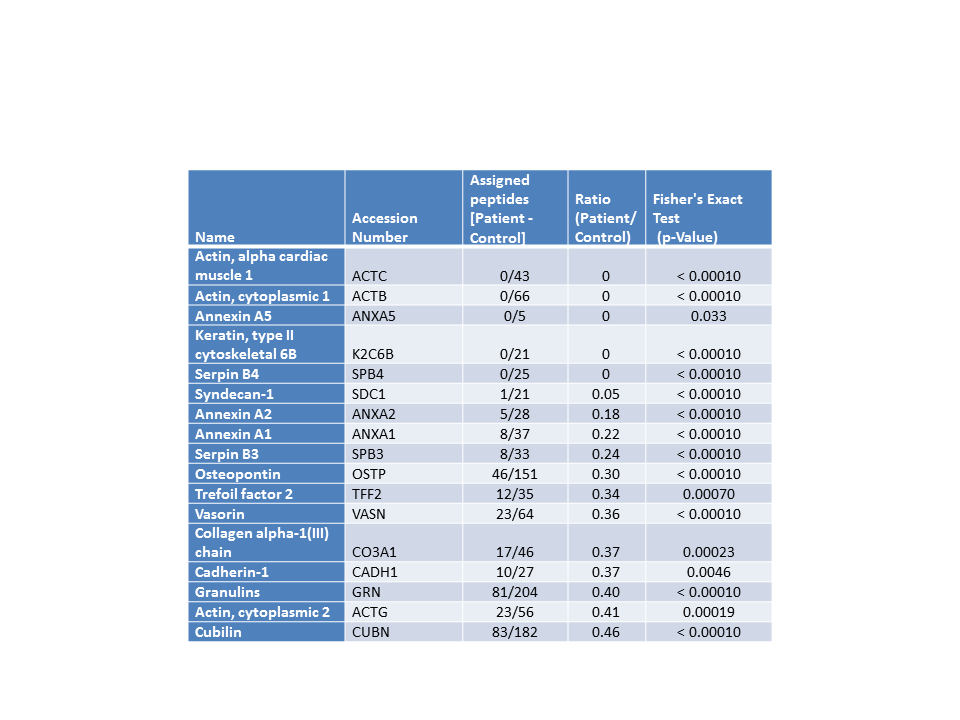Back
Poster, Podium & Video Sessions
Late-breaking Abstract II - Benign Disease
LBA02-03: Marked Reduction of Urinary Excretion of Osteopontin in Children with Urolithiasis and Hypocitraturia
Sunday, May 15, 2022
3:50 PM – 4:00 PM
Location: Room 243
Larisa Kovacevic, Yegappan Lakshmanan
- LK
Podium Presenter(s)
Introduction: Using a proteomic approach, we aimed to screen for the presence of biomarkers that are down regulated in children with urolithiasis (RS) compared to healthy controls (HC). We hypothesized that RS and HC would display unique inhibitory protein profiles that could be used for comparative pathway analysis.
Methods: This is a prospective, controlled, pilot study of pooled urine from RS (N=30, 24 females, mean age 12.95±4.03 years) versus age- and gender-matched healthy controls (HC), using liquid chromatography-mass spectrometry (LC-MS/MS). Relative protein abundance was estimated using spectral counting. The criteria for protein selection were: 1) patient/control abundance ratio of <0.5 as a threshold to be well above observed technical variations in MS experiments; and 2) =0.05 p-value for the Fisher’s Exact Test. Results were confirmed by ELISA testing in individual samples. Statistical analyses were conducted with IBM SPSS® version 20.
Results: Overall we identified 1813 proteins, with 1639 proteins found in children with urolithiasis, and 1396 proteins found in controls. Of those, 417 were found only in patients and 174 only in controls. Using the above mentioned criteria, 67 proteins were down-regulated in RS group, and 17 of those were significantly different (Table). Protein-protein interaction modeling of significant proteins identified syndecan-1 as the key node, a protein associated with adhesion pathways. ELISA analysis by subgroups showed statistically significant difference in the urinary excretion of osteopontin (5.1± 3.22 ng/mg creatinine vs 14.1 ±9.5 ng/mg creatinine, p=0.046) between stone patients with hypocitraturia and controls. Urinary osteopontin concentration was positively correlated with urinary citrate excretion (r=0.417, p=0.03).
Conclusions: Children with RS have a different urinary inhibitory polypeptide profile compared to HC. Decreased urinary excretion of these proteins suggests their potential inhibitory role in renal stone formation, especially of the adhesion phase. Lower concentration of urinary osteopontin in children with urolithiasis and hypocitraturia indicates its potential involvement in the pathogenesis of this disease. Further characterization of this protein in a larger population of pediatric stone formers is imperative.
Source of Funding: Children’s Hospital of Michigan Foundation

Methods: This is a prospective, controlled, pilot study of pooled urine from RS (N=30, 24 females, mean age 12.95±4.03 years) versus age- and gender-matched healthy controls (HC), using liquid chromatography-mass spectrometry (LC-MS/MS). Relative protein abundance was estimated using spectral counting. The criteria for protein selection were: 1) patient/control abundance ratio of <0.5 as a threshold to be well above observed technical variations in MS experiments; and 2) =0.05 p-value for the Fisher’s Exact Test. Results were confirmed by ELISA testing in individual samples. Statistical analyses were conducted with IBM SPSS® version 20.
Results: Overall we identified 1813 proteins, with 1639 proteins found in children with urolithiasis, and 1396 proteins found in controls. Of those, 417 were found only in patients and 174 only in controls. Using the above mentioned criteria, 67 proteins were down-regulated in RS group, and 17 of those were significantly different (Table). Protein-protein interaction modeling of significant proteins identified syndecan-1 as the key node, a protein associated with adhesion pathways. ELISA analysis by subgroups showed statistically significant difference in the urinary excretion of osteopontin (5.1± 3.22 ng/mg creatinine vs 14.1 ±9.5 ng/mg creatinine, p=0.046) between stone patients with hypocitraturia and controls. Urinary osteopontin concentration was positively correlated with urinary citrate excretion (r=0.417, p=0.03).
Conclusions: Children with RS have a different urinary inhibitory polypeptide profile compared to HC. Decreased urinary excretion of these proteins suggests their potential inhibitory role in renal stone formation, especially of the adhesion phase. Lower concentration of urinary osteopontin in children with urolithiasis and hypocitraturia indicates its potential involvement in the pathogenesis of this disease. Further characterization of this protein in a larger population of pediatric stone formers is imperative.
Source of Funding: Children’s Hospital of Michigan Foundation


.jpg)
.jpg)